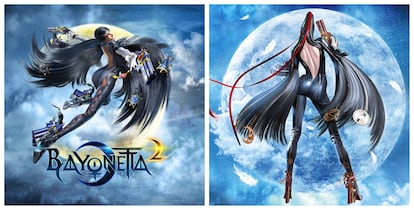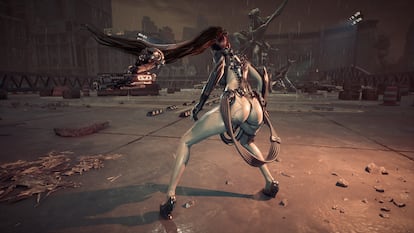Her breasts are disproportionate and bounce with every step. The camera focuses on her butt every time she climbs a staircase. Despite the rugged terrain, she is wearing heels, a detail that the spotlights also tend to focus on. In addition, one option allows her to wear a flesh-colored suit, which further suggests the fantasy that she fights naked. Her name is Eve, and she is dedicated to fighting giant insects. She is the protagonist of Stellar Bladea successful Korean video game released a few weeks ago, and its appearance has unleashed a war between internet users.
But Eve is not the only example of this type of recent hypersexualized representation. The Tifa of Final Fantasy VII, with its extremely exaggerated bust; the stillness of Metal Gear Solid V, a sniper who had to wear a bikini because she breathed through her skin; or the impossible curves of Lady Dimitrescu, from Resident Evil Village and of Bayonettaof the games of the same name, have revived the fears of those who suspect that video games once again exhibit hypersexualized female characters, in a movement that contrasts with the evolution that the sector has been carrying out for years.
“The majority of visual arts – photography, cinema, comics – have always been developed from a male prism. The man looked, and the woman was the object looked at,” says Marta Trivi, journalist specialized in video games and co-author of I protest! Video games from a gender perspective (Anait). “But artists have always emerged who have become aware of this. It was criticized in painting in the second wave of feminism, in cinema, in comics… it is a recurring theme. In video games, it has happened in recent years: there has been a movement that detected that the objectification of women was not only constant, but also very evident, and fought against it.”

“After 2010, the video game industry entered the era of modern gaming and female characters began to show notable diversity and complexity. Compared to previous times, they became more independent, powerful and were characterized by exhibiting different personalities. Furthermore, there was a tendency towards desexualization and towards neutralization in their appearance,” Lan Luo X-rays in a recent study (The Evolution of Female Character Representations in Video Games from a Feminism Perspective) from Nanyang Technological University, Singapore. The new heroines, like Ellie and Abby from the zombie saga The Last of Us, or the Aloy of the game with metal beasts Horizon, They are very different: they represent an archetype of a real woman who stands out for her actions and personality, not for her physique.
The very evolution of a character like Lara Croft shows this: from the retreaded form that she looked like in the first games of Tomb Raider Until its redesign towards reality in 2013, it mediates the change in mentality of an industry in which the different communities have been articulated in forums and networks to sustain a critical discourse against the machismo prevailing in the industry decades ago. And part of this change can be attributed to the incorporation of women as consumers. The video game sector grows every year (a study by the consulting firm DFC Intelligence estimates that there are 3,100 gamers in the world, almost 40% of the population). In Spain they have exceeded 18 million, according to the latest reports from the Spanish Video Game Association. Although women already make up almost half of the players (47%), there are less encouraging figures: they only represent 17% of the workforce and there are only 20% of female protagonists.
“In recent years this sexualization has been fought against,” Trivi contextualizes. “But, at the same time, every movement has a countermovement that tries to return things to the way they were before. And they disguise it as rebellion.” That’s what they seem to be aiming at not only Stellar Blade, but characters like Tifa, Lady Dimitrescu or Quiet. All of these characters, by the way, appear in Japanese games. Stellar Blade It’s Korean. Which has added another debate to the controversy: is Asia more sexist than the West when it comes to video games?

Trivi remembers certain social demands in recent years, specifically in Korea, in the heat of books like Kim Ji-young, nacida en 1982, a recent feminist reference throughout the region. But she returns to her theory of the countermovement: “Works like that have made machismo stronger. And I don’t doubt that Stellar Blade It is one of these games that is not only created in a sexist context, but is masked under a form of ‘rebellion’. Regardless of the representation of women, there have also been ideological movements that are at least questionable. As a button shows: in 2019 and convinced that video games were behind the drop in the birth rate, China (the country in the world that invests the most money in games) forced some of the largest companies, such as Tencent, miHoYo or NetEase, to limit the inclusion of “effeminate” male people. “The only objective is to seek profit and not include violent or obscene content, such as the cult of money or effeminacy,” the authorities stated at the time.
The controversy of Stellar Blade has inflamed social networks, in what seems like a new chapter of the Gamergate (fight between conservative and progressive players) that began in 2014 and that largely advocated the cultural wars that have taken place during this decade. That dispute had a notable episode at the end of March, when the name of a company went around the digital world: Sweet Baby. Founded in 2018 and based in Montreal (Canada), it offers consulting to several video games during their development to promote diversity in their characters. Although it only has 16 employees, it has been involved in some of the most successful and expensive games of recent times, such as Spider-Man 2 (which features a gender-neutral scientist), God of War. Ragnarok (in which a giantess from Norse mythology, Angerboda, is a black girl) or Alan Wake 2 (whose co-star is black). “We are a narrative company. We are not censors. We are interested in improving the stories, developing a more solid language around narrative design,” the specialized media defended. My city Kim Belair, CEO of Sweet Baby. However, a sector of the Internet that is very active in networks denounced “forced inclusion” in those games, and is now demanding the return of characters like Eve from Stellar Bucket.
All in all, video games belong to the world of art. An area in which creative freedom and political correctness go poorly together. Wanting to be a little provocative, Trivi introduces one last nuance: “There are games in which sexualization is evident and annoying, but it is difficult to judge from a feminist point of view because it can be related to what we do in the game.” The clearest example?: “Without a doubt, Bayonetta”. “It is so exaggerated, with those proportions that highlight her curves so much… at first it seemed bad to me, but over time I have seen that many people queer claims it as a symbol camp (voluntarily exaggerated). It is so, but so exaggerated, that, to what extent is it attractive to regulations? Maybe it’s a parody of sexy,” she slips. It is evident that the controversy is served.
Subscribe to continue reading
Read without limits
_

